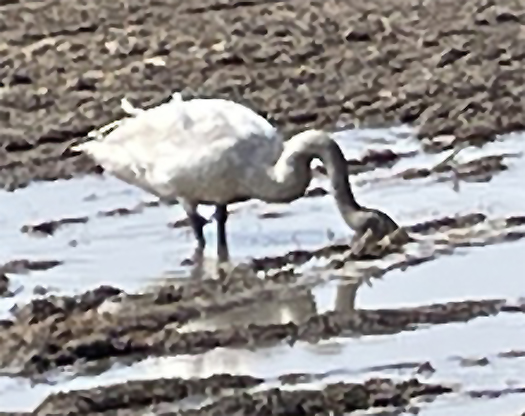
宮島沼の探訪では今回、学芸員とおぼしき方から鳥の生態について説明を受けることが出来た。わたしたち夫婦のような「なんとなく鳥ってかわいい」くらいの人間には非常にためになった。
今回宮島沼の訪問時間は真昼時間だったので、鳥たちは沼にはいなくて、周辺の田畑、それもまだ北海道らしく耕作着手前の泥濘状態に広く展開していた。そこで目敏く発見したハクチョウたちの群。あまり警戒されないようにしずかに近づいてみると、ごらんのようなポーズで一心不乱に泥濘に首を突っ込んでいる。
足が折れてやがて化身したとされるヤマトタケルは、やはりハクチョウに変身したのではないかと勝手に想像しているけれど、そうしたハクチョウもおなかは空く。さてこのポーズでなにを食しているか。
学芸員の方からの説明・受け売りでは、土中の昆虫類を食べているのではないかというわたしたち夫婦の素朴な決め込みは大きな間違いで、かれらハクチョウは「草食性」であるので、植物の根の残骸を探し当てているのだと。そしてそれを器用に解体処理させながら、口中に捕食していくのだというのですね。
そういう知識を持って見返すと、すこしだけハクチョウさんたちとの距離感が狭まった気がしてくる(笑)。
畠などで前年の耕作作物の根の部分は翌年以降の栽培のための「肥料」として残置されるのでしょうが、まぁ特段残っている必要もないのでしょう。むしろ、こうしてハクチョウたちがついばんでくれることは、整地作業のヘルプにもなるのでしょう。人間と自然動物との協働。
そんなふうにとらえ返せると、ハクチョウたちへの視線にもある感謝の感情が湧いてくる。ありがとね、君たちのおかげで人間の手間が削減されているよ、と。
でも、大空を飛ぶほどのあれほどの運動活性の動物が草食性というのも、すごいことかと。
しかしそこから日本の基盤である栽培農業の田畑に対して、かれら渡り鳥たちが果たしてくれてきた協働ということに思いが向かっていくと、なにか深遠な光景もほの見えてくる。ヤバい、鳥たちへの愛が・・・。
English version
What do swans peck at in the mud?
The relationship between migratory birds and human agriculture, which has continued uninterruptedly in archipelagic societies. The birds’ casual poses are endearing. …
During our visit to Miyajima Swamp, we were given an explanation of bird ecology by a person who appeared to be a curator. This was very useful for people like us who only know that birds are kind of cute.
The birds were not in the swamp because it was midday when we visited Miyajima Swamp this time, but in the surrounding fields, which were still in the muddy state before they were ploughed, as is typical of Hokkaido. A flock of swans was spotted there. I approached them quietly so as not to alarm them too much, and found them in the same pose as you can see, poking their necks into the mud with a single-minded devotion.
I imagine that Yamatotakeru, whose leg is said to have been broken and eventually transformed into a swan, was also transformed into a swan, but even these swans are hungry. What are they eating in this pose?
The curator explained to us that our naive assumption that they eat insects from the soil was a big mistake, as these swans are herbivores and search for plant root debris. They then dexterously dismantle them and feed on them in their mouths.
When I look back at the swans with this knowledge, I feel that I have become a little closer to them (laughs).
The roots of the previous year’s crops are probably left as “fertiliser” for the following year’s cultivation, but there is no particular need for them to remain. The swans’ pecking helps with the land preparation work. Cooperation between humans and animals.
If you look back at it in this way, a certain feeling of gratitude comes to your gaze. Thanks to you, we are able to reduce the amount of work humans have to do.
But I also think it’s amazing that an animal with such athletic activity that it can fly so high in the sky is also herbivorous.
However, when I think about the cooperation that these migratory birds have provided to the fields of cultivated agriculture, which is the foundation of Japan, I begin to see a profound picture. Oh no, my love for birds…
Posted on 4月 9th, 2025 by 三木 奎吾
Filed under: 日本社会・文化研究








コメントを投稿
「※誹謗中傷や、悪意のある書き込み、営利目的などのコメントを防ぐために、投稿された全てのコメントは一時的に保留されますのでご了承ください。」
You must be logged in to post a comment.